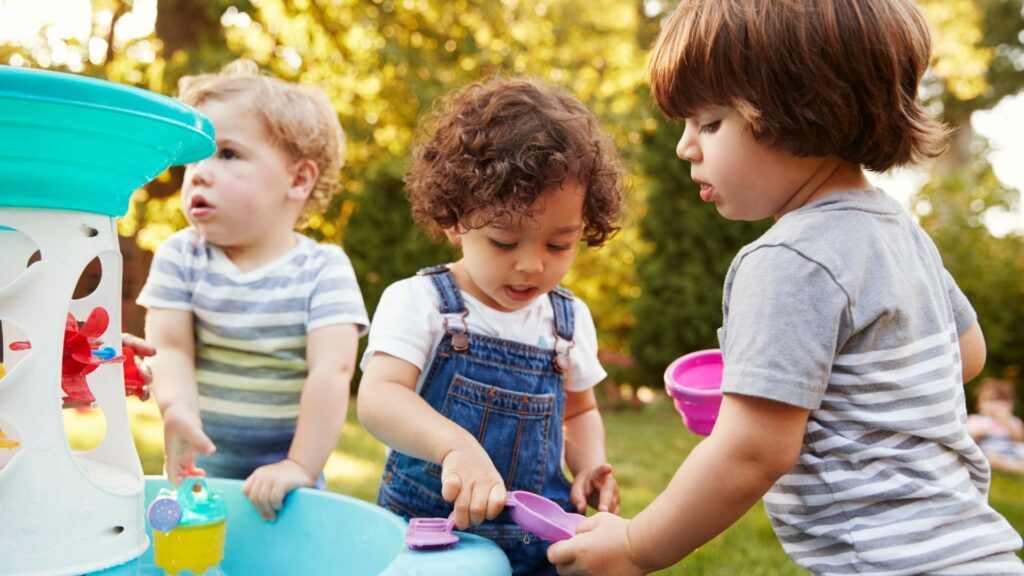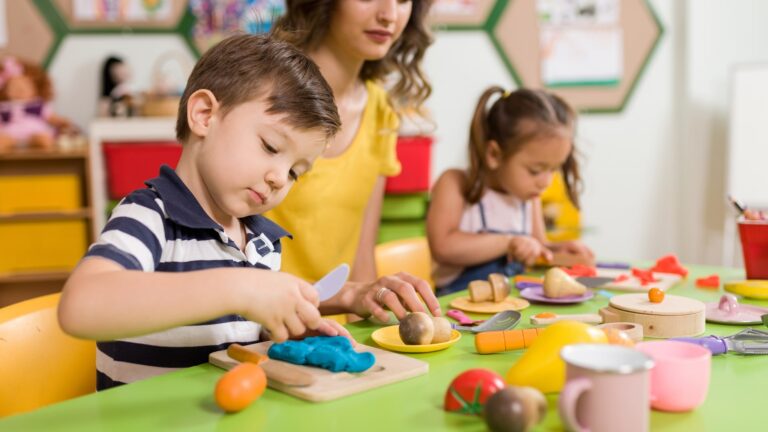Nurturing Emotional Intelligence in Children
In the delicate art of caregiving and teaching, understanding children’s behavior resembles deciphering a rich tapestry of emotions and needs. Each tantrum, sullen silence, or exuberant outburst tells a story waiting to be heard. At the core of this understanding lies the profound impact of responding with patience and insight—an essential element in nurturing emotional intelligence in children.
Building Trust Through Patience and Understanding
Patience isn’t just a virtue; it’s a powerful tool for caregivers and educators. When children feel surrounded by patience and understanding, trust naturally grows. This trust forms the fertile soil where emotional intelligence seeds take root and flourish. Whether in the classroom or at home, the assurance of being heard and valued empowers children to explore their emotions confidently.
Let’s delve into a practical example for early childhood educators on how to build trust through patience and understanding.
Scenario
Imagine a preschool classroom where a new student, Sarah, has recently joined. Sarah is shy and reserved, often sitting alone during playtime and avoiding interaction with her peers. As her educator, you notice Sarah’s hesitancy to engage with others and sense her discomfort in the new environment.
Practical Approach
1. Observation and Patience
Begin by observing Sarah’s behavior without judgment. Notice her body language, facial expressions, and interactions with her surroundings. Resist the urge to intervene immediately and instead, practice patience. Understand that Sarah may need time to adjust to the new environment and build trust with her caregivers and peers.
2. Building Rapport
Approach Sarah with warmth and empathy, showing genuine interest in her well-being. Engage her in simple conversations, focusing on topics she enjoys or feels comfortable discussing. By demonstrating kindness and understanding, you lay the foundation for a trusting relationship.
3. Creating a Safe Space
Foster an environment where Sarah feels safe to express herself authentically. Provide opportunities for her to participate in small group activities or one-on-one interactions with supportive peers. Emphasize the importance of respect and empathy among classmates, encouraging inclusive behavior.
4. Establishing Predictability
Consistency is key in building trust. Create predictable routines and rituals within the classroom, offering Sarah a sense of security and stability. Clearly communicate expectations and transitions, allowing her to anticipate and prepare for upcoming activities.
5. Encouraging Autonomy
Empower Sarah by offering choices and opportunities for self-directed play. Respect her preferences and interests, allowing her to explore and discover at her own pace. Celebrate her achievements, no matter how small, to boost her confidence and sense of competence.
6. Responsive Support
Remain attuned to Sarah’s cues and needs, offering support and reassurance as required. Validate her emotions and experiences, acknowledging any challenges she may encounter. By being responsive and empathetic, you demonstrate your commitment to her well-being and build trust over time.
Outcome
Through your patient and understanding approach, Sarah gradually begins to feel more comfortable and secure in the classroom environment. She starts to participate in group activities, interact with her peers, and express herself more confidently. As trust continues to grow between Sarah and her caregivers, she blossoms into a resilient and engaged learner, eager to explore the wonders of early childhood education.

The Art of Insightful Response
In caregiving, insight is the compass guiding us through children’s emotions. It urges us to look beyond the surface and delve into their inner world. Instead of reacting to behavior, responding with insight involves a reflective pause—a chance to decipher the underlying emotions and unmet needs driving actions. This practice not only nurtures a deeper connection but also fosters empathy in children, helping them understand their own emotions and those of others.
Let’s explore a practical example for early childhood educators on how to apply the art of insightful response.
Scenario
In a preschool classroom, James frequently exhibits disruptive behavior during group activities. He often interrupts others, refuses to follow instructions, and becomes agitated when things don’t go his way. As his educator, you sense that there may be underlying emotions and needs driving James’ behavior.
Practical Approach
1. Observation and Reflection
Begin by observing James’ behavior closely, paying attention to the triggers and patterns underlying his actions. Reflect on possible reasons for his behavior, considering factors such as his temperament, home environment, and past experiences. Resist labeling James as “difficult” and instead approach his behavior with curiosity and empathy.
2. Empathetic Engagement
Engage James in a one-on-one conversation, approaching him with warmth and empathy. Instead of reprimanding him for his behavior, express genuine concern for his well-being. Use open-ended questions to encourage James to share his thoughts and feelings, creating a safe space for him to express himself without fear of judgment.
3. Exploring Emotions
Help James identify and label his emotions, validating his experiences without dismissing them. Use visual aids such as emotion cards or storybooks to illustrate different feelings and their expressions. Encourage James to reflect on times when he felt similar emotions and how he coped with them.
4. Understanding Triggers
Collaborate with James to identify the triggers that lead to his disruptive behavior. Explore any specific situations or events that seem to provoke strong reactions from him. By understanding the root causes of his behavior, you can develop strategies to support James in managing his emotions more effectively.
5. Teaching Self-Regulation
Equip James with tools and techniques to regulate his emotions and behaviors. Practice deep breathing exercises or mindfulness activities together, teaching James how to pause and center himself when feeling overwhelmed. Encourage him to use positive self-talk and affirmations to boost his confidence and resilience.
6. Positive Reinforcement and Encouragement
Recognize and celebrate James’ efforts and progress towards positive behavior. Offer specific praise and encouragement when he demonstrates self-regulation and respectful interactions with others. Create a reward system or incentive chart to motivate James to continue making positive choices.
Outcome
Through your insightful response and empathetic support, James begins to develop a deeper understanding of his emotions and behaviors. He learns to recognize his triggers and implement strategies to regulate his reactions more effectively. As James gains confidence in managing his emotions, his disruptive behavior gradually diminishes, and he becomes more engaged and cooperative in the classroom. By fostering a culture of empathy and understanding, you empower James to thrive emotionally and academically in the early childhood setting.

Empowering Emotional Regulation and Expression
Emotional intelligence isn’t just about recognizing and understanding emotions; it’s also about regulating and expressing them appropriately. By responding with patience and insight, caregivers and educators provide a safe space for children to navigate their emotional landscape. Through gentle guidance and validation, children learn that emotions are natural, laying the foundation for healthy coping strategies and resilient problem-solving skills.
Let’s explore a practical example for early childhood educators on how to empower emotional regulation and expression.
Scenario
In a kindergarten classroom, Emma often struggles with expressing her emotions in a constructive manner. She frequently becomes overwhelmed with frustration during challenging tasks and resorts to crying or lashing out at her peers. As her educator, you recognize the importance of empowering Emma to regulate her emotions and express herself in healthier ways.
Practical Approach
1. Creating a Safe Environment
Establish a nurturing and supportive classroom environment where Emma feels comfortable expressing her emotions without fear of judgment. Emphasize the importance of emotional safety and respect among classmates, fostering a culture of empathy and understanding.
2. Emotion Identification
Begin by helping Emma identify and label her emotions. Use emotion posters or facial expression cards to illustrate different feelings, encouraging Emma to recognize and name her emotions when she experiences them. Validate her feelings and reassure her that it’s okay to feel whatever she’s feeling.
3. Mindfulness Practices
Introduce Emma to simple mindfulness exercises to help her regulate her emotions in the moment. Teach her techniques such as deep breathing or progressive muscle relaxation to calm her mind and body during times of stress or frustration. Practice these exercises together regularly to reinforce their effectiveness.
4. Emotion Regulation Strategies
Collaborate with Emma to develop personalized emotion regulation strategies that work for her. Explore different coping mechanisms such as taking a break in a quiet corner, using a stress ball or fidget toy, or engaging in a calming sensory activity like drawing or listening to music. Encourage Emma to use these strategies whenever she feels overwhelmed.
5. Encouraging Expression
Create opportunities for Emma to express her emotions in healthy and constructive ways. Incorporate activities like journaling, art therapy, or role-playing to help Emma explore and articulate her feelings. Provide a supportive space for her to share her thoughts and experiences without judgment.
6. Modeling and Reinforcement
Model positive emotion regulation techniques and expressive communication skills in your interactions with Emma and the rest of the class. Praise and reinforce Emma’s efforts when she demonstrates progress in regulating her emotions and expressing herself effectively. Celebrate her successes, no matter how small, to boost her confidence and motivation.
Outcome
Through your efforts to empower Emma in regulating her emotions and expressing herself, she begins to develop greater self-awareness and emotional resilience. She learns to recognize her triggers and implement strategies to manage her emotions more effectively. As Emma gains confidence in expressing herself, her interactions with her peers become more positive and cooperative. By fostering a supportive and nurturing environment, you empower Emma to navigate the complexities of her emotions with grace and resilience in the early childhood classroom.

Fostering Communication and Connection
Communication is vital for human connection—a bridge between hearts and minds. When children feel heard and understood, they’re more likely to express themselves verbally. By fostering open communication through patient and insightful responses, caregivers and educators create a culture of trust—a sanctuary where every voice is valued.
Let’s explore a practical example for early childhood educators on how to foster communication and connection.
Scenario
In a preschool classroom, Daniel struggles to communicate his thoughts and feelings effectively. He often becomes frustrated when he can’t express himself verbally, leading to tantrums or withdrawal from social interactions. As his educator, you recognize the importance of fostering communication skills and building connections with Daniel and his peers.
Practical Approach
1. Creating a Communicative Environment
Establish a warm and inviting atmosphere where open communication is encouraged. Set aside dedicated times for group discussions, storytelling, and sharing circle activities. Create opportunities for children to express themselves through verbal and nonverbal means, such as art, music, and movement.
2. Supportive Language Modeling
Model clear and effective communication skills in your interactions with Daniel and the rest of the class. Use simple and age-appropriate language, gestures, and facial expressions to convey meaning and facilitate understanding. Encourage turn-taking and active listening during conversations to promote respectful communication.
3. Visual Supports and Communication Aids
Provide visual supports and communication aids to assist Daniel in expressing himself more effectively. Use picture schedules, visual timetables, and communication boards to help him understand routines and express his needs and preferences. Offer alternative modes of communication, such as sign language or visual symbols, to supplement verbal communication.
4. Encouraging Peer Interaction
Facilitate opportunities for Daniel to interact and communicate with his peers in small group settings. Plan collaborative activities and cooperative play experiences that require children to work together and communicate effectively. Assign peer buddies or partners to support Daniel in social interactions and encourage mutual understanding and empathy.
5. Promoting Social Skills Development
Teach Daniel and his peers essential social skills, such as sharing, taking turns, and problem-solving. Use role-playing scenarios and social stories to demonstrate appropriate social behaviors and responses. Provide guidance and support as children navigate social interactions, offering constructive feedback and praise for positive communication efforts.
6. Celebrating Communication Milestones
Celebrate Daniel’s progress and achievements in communication, no matter how small. Recognize his efforts in expressing himself verbally and nonverbally, and acknowledge his contributions to group discussions and activities. Create a supportive environment where all children feel valued and empowered to communicate confidently.
Outcome
Through your intentional efforts to foster communication and connection in the classroom, Daniel begins to develop greater confidence and competence in expressing himself and interacting with others. He learns valuable communication skills that will serve him well in future social and academic settings. As Daniel builds connections with his peers and educators, he experiences a sense of belonging and inclusion within the classroom community. By nurturing communication skills and fostering meaningful connections, you empower Daniel and his peers to thrive in their early childhood experiences.
Cultivating Emotional Intelligence for Lifelong Success
Emotional intelligence shines as a beacon of resilience and well-being in childhood. By responding with patience and insight, caregivers and educators sow the seeds of lifelong emotional intelligence. Through trust, understanding, and compassionate guidance, children learn to navigate life’s complexities with grace and resilience, equipped with the invaluable gift of emotional intelligence.

Elevate your teaching skills and stay ahead of the curve! Receive our monthly Insights, packed with professional development opportunities, classroom inspiration, and the latest trends in education. Don’t miss out on the chance to take your teaching to the next level. Subscribe now!







